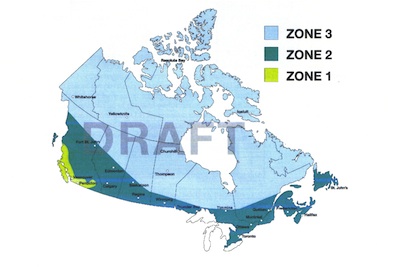
 Nov. 16, 2012 – At Win-Door 2012, Steve Hopwood of Natural Resources Canada introduced a number of proposed updates and changes to the Energy Star program. Proposed criteria for adding windows to Energy Star's Most Efficient recognition program were discussed, as well as changes to the Energy Star technical specification, including climate zones.
Nov. 16, 2012 – At Win-Door 2012, Steve Hopwood of Natural Resources Canada introduced a number of proposed updates and changes to the Energy Star program. Proposed criteria for adding windows to Energy Star's Most Efficient recognition program were discussed, as well as changes to the Energy Star technical specification, including climate zones.
Nov. 16, 2012 – At Win-Door 2012, Steve Hopwood of Natural Resources
Canada introduced a number of proposed updates and changes to the Energy
Star program. Proposed criteria for adding windows to Energy Star's
Most Efficient recognition program were discussed, as well as changes to
the Energy Star technical specification, including climate zones.
Energy Star is proposing to include residential window products in its Most Efficient designation starting Jan. 1, 2013. By "residential," it means buildings falling under Part 9 of the National Building Code of Canada: three stories or less high and 600 square meters or less building area. Commercial windows, doors, skylights and tubular daylighting would not be recognized in the 2013 program.
1. Recognition criteria for eligible products would be as follows:
2. Manufactured in Canada by a participant in the Canadian Energy Star initiative.
3. Sold in Canada, registered with Energy Star and listed on the Energy Star website.
4. Meets version 3.0 of the Energy Star Qualifying Criteria for Residential Windows, Doors and Skylights Sold in Canada.
5. Certified for physical performance as per Section 3 of the Criteria and meet or exceed one of the window standards found in Section 6 (CSA A440.0-00, AAMA/WDMA/101/I.S.2/-97, or AAMA/WDMA/CSA101/I.S.2/A440 – 05/08).
6. Must have an Energy Rating of 36 (unitless) or higher
Or
6. Have a U-factor of 1.13 or lower and a solar heat gain coefficient of 0.2 or higher.
Recognized products will be listed on the Energy Star website and searchable. Manufacturers may display the Most Efficient Energy Star logo on the product.
Technical specifications
Proposed changes to the Energy Star technical specifications include alteration of the climate zone map. NRCan proposes to eliminate Zone 4, bringing the map into more agreement with the Model National Energy Code for Houses. The new zones will be named 1, 2 and 3, and use Heating Degree Day values as found in the MNBC. Zone 1 refers to an area with fewer than 3,500 HDDs, Zone 2 3,500 to 6,000 HDDs and Zone 3 over 6,000 HDDs.
 |
|
| Proposed changes to the Energy Star climate zones reduce the number of zones from four to three.
|
Energy Star qualifying criteria have been made more stringent for 12 out of 20 Canadian areas. NRCan proposes to eliminate the U-factor cap in the Energy Rating compliance path. A statement indicating that Energy Star models must meet or exceed all applicable provincial and municipal building codes will be included in the specification. Only U-factors in watts per square meter will be shown in the qualifying levels tables, with Imperial conversions in an appendix. Minimum ER values in the U-factor path will be changed to solar heat gain coefficient values. Sliding glass doors will have to meet or exceed a minimum SHGC value for the U-factor path in each zone.
NRCan is proposing to add a requirement for certification of physical performance for air leakage for Energy Star-qualified windows, sliding glass doors and skylights. Windows, sliding glass doors, skylights, sidelites and transoms would have to be certified to pass less than 1.5 liters per second per square meter. Hinged doors would be allowed to pass up to 2.5 liters per second per square meter.
Energy Star presently requires installation instructions to be shipped to the end-user along with any Energy Star-rated product. NRCan proposes to amend this requirement allowing electronic versions posted on websites to be an acceptable alternative. Both kinds of instructions will be required to have a list of hardware and tools necessary for installation, diagrams and pictures, guidance on how to remove old products, opening preparation, flashing and shimming instructions and guidance on sealing and weatherstripping.
Comments on the proposed changes can be sent to Steve Hopwood at shopwood@nrcan.gc.ca until Dec. 16. Only written comments will be considered.
Related links
www.nrcan.gc.ca
Print this page
Leave a Reply